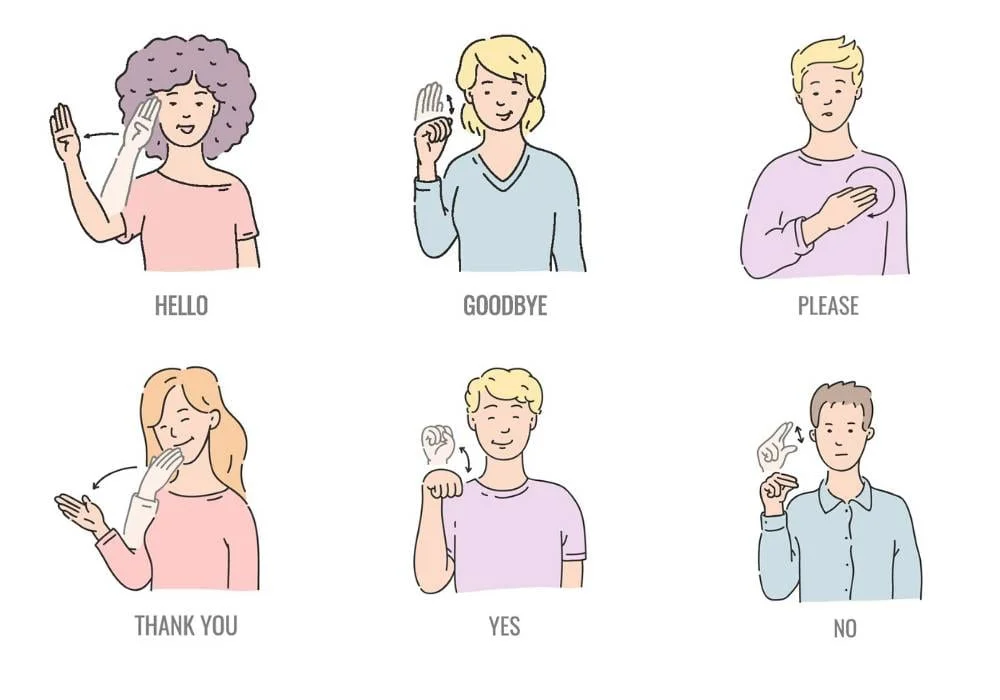Sign language does not only facilitate communication but also forms part of the deaf community’s identity and culture. Learning sign language brings understanding and connection into an individual’s world, providing numerous cognitive, social, and emotional benefits.
This piece will look thoroughly at sign languages giving suggestions for anyone who wants to learn this unique but powerful form of communication.
What is Sign Language?
Definition and Basics
Deaf people use Sign Language as a visual-gestural form. This involves the use of hand shapes, facial expressions, and body movements, unlike spoken languages, which rely on sound alone, such as high-pitched sounds made in speech. As such, it serves as an effective mode of communication for individuals with hearing impairments because they can see everything that is being said (Sutton-Spence & Woll 1999).
There are many reasons why gesture plays such an important role in human communication, from pointing out objects during conversation and expressing emotions or feelings when indicating spatial relationships between entities like distances or locations, etc. Hence, these manual languages enrich interactions by combining them with several other expressive tools.
Components
- Hand Shapes: These configurations represent the fundamental elements of sign language sentences.
- Movements: The meaning behind these movements depends on how hands move within space along with their directions.
- Facial Expressions: They show intonation in sign languages just like they do in spoken languages.
- Body Language: This includes postures and gestures that provide additional meaning and context to the communication, thereby emphasizing or modifying the message encoded by hand signals.
Benefits
Cognitive Benefits
Sign language acquisition enhances cognitive functions like memory recall, spatial understanding, and problem-solving abilities, which individuals possess. Bilingualism, including fluency in a signed language like American Sign Language, has been demonstrated to enhance mental flexibility and creativity (Frishberg, 1992).
Language learning utilizes different areas within the brain, thus increasing total mental capacities that benefit individuals throughout their lives.
Social Benefits
Inclusivity and bridging of gaps in communication among the hearing and deaf communities is facilitated by sign language. It promotes empathy and understanding, thus enhancing more purposeful engagements and interactions.
In essence, this form of communication helps hearing people to connect with deaf people using their preferred mode of communication hence creating an inclusive environment.
Professional benefits
Sign language knowledge is a useful asset in several career fields like education, health care, and customer care among others that can create employment opportunities or boost job performance.
Because employers appreciate those who communicate in sign language for their commitment to embracing diversity, such employees are often given priority when it comes to considering overall company culture.
Emotional Benefits
For the deaf, learning sign languages can boost one’s self-esteem and confidence as they can express themselves effectively while interacting with other people.
On the other hand, acquiring proficiency in sign language also gives some individuals a sense of pride besides connecting them to a larger society thus promoting both personal and professional growth.
10 COMMON SIGNS IN SIGN LANGUAGE
Communication becomes easier if you learn basic signs in sign language. Here is a list of some common signs; each has been described below in detail to get you started.
Toilet in sign language
The sign for toilet in the sign language is very simple and straightforward. To make this gesture, you clench your dominant hand into a fist shape with your thumb sticking out like an American Sign Language (ASL) representation of the letter “T.”
Slightly rotate your wrist back and forth just like shaking a little thing, which signifies turning doorknob indicating where washrooms are found at home or any other premises. You may want to practice this signal so that you will be able to tell this important need rapidly within different environments.
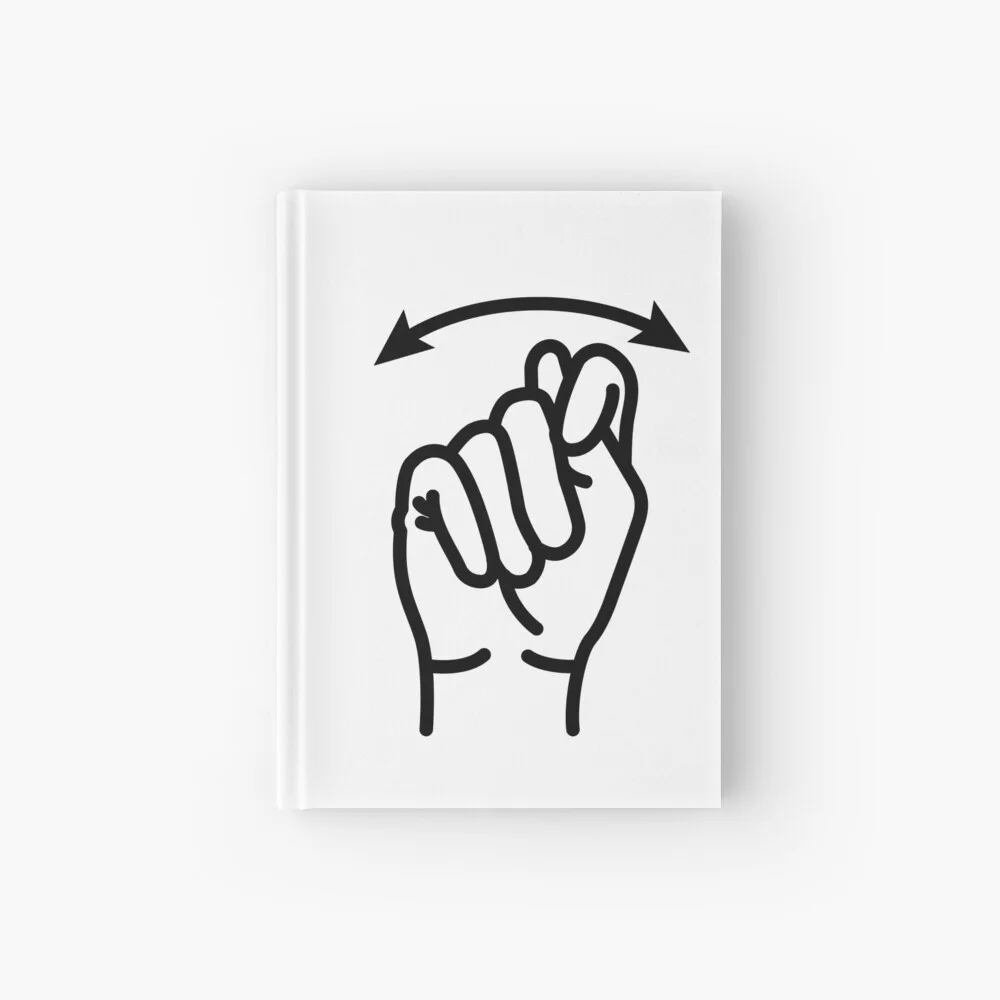
EAT/FOOD
To represent eating or food, use your dominant hand to mimic holding a small piece of food as it goes into your mouth. You do this several times to show food going into the mouth. It is a very easy sign to learn since it is quite logical and can be added to one’s vocabulary for practical purposes. I
n a clear way that everybody will understand, you can inform someone about being hungry or needing to eat by employing this symbol.

DRINK
The sign for “drink” involves making a “C” shape with your dominant hand which you move towards your mouth as if sipping an imaginary glass of drink. Do this motion twice or thrice to make sure that its meaning stays in one’s mind.
The gesture is simple, but it works very well – it lets others know when we are thirsty. In any social context where people gather around together for drinks, this gesture makes communication easier on their drinking requirements.
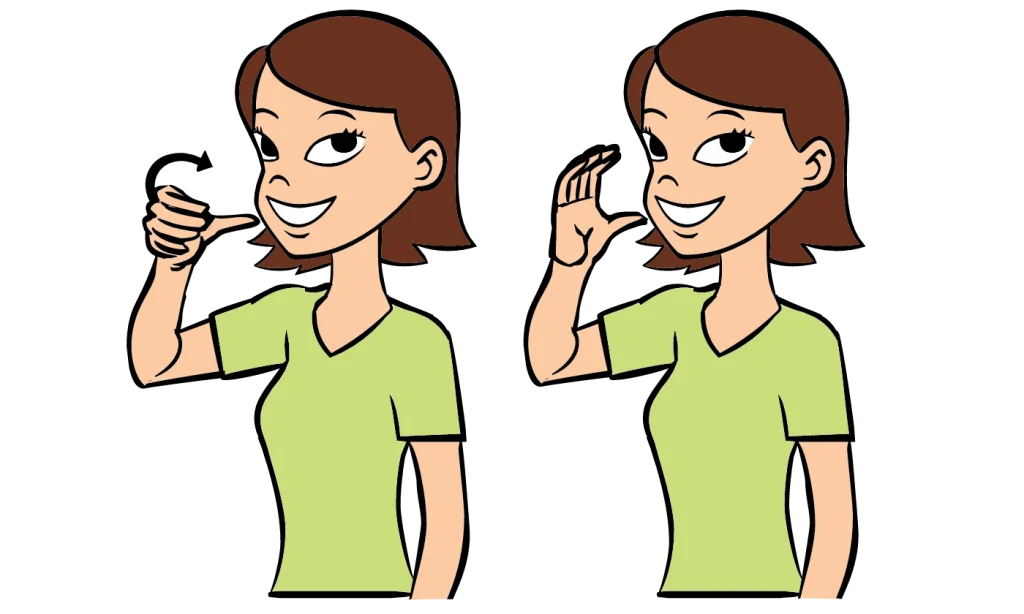
HELP
To communicate help, place your thumb upwards using the same hand that was used before and rest it onto the open palm of the other hand. Push both hands up simultaneously indicating extending assistance to somebody who needs help.
This signal comes in handy whenever there is a need either to give or ask for some aid in various situations. By practicing this signal, you will be able to relate with others better thereby promoting supportiveness and cooperation between people.
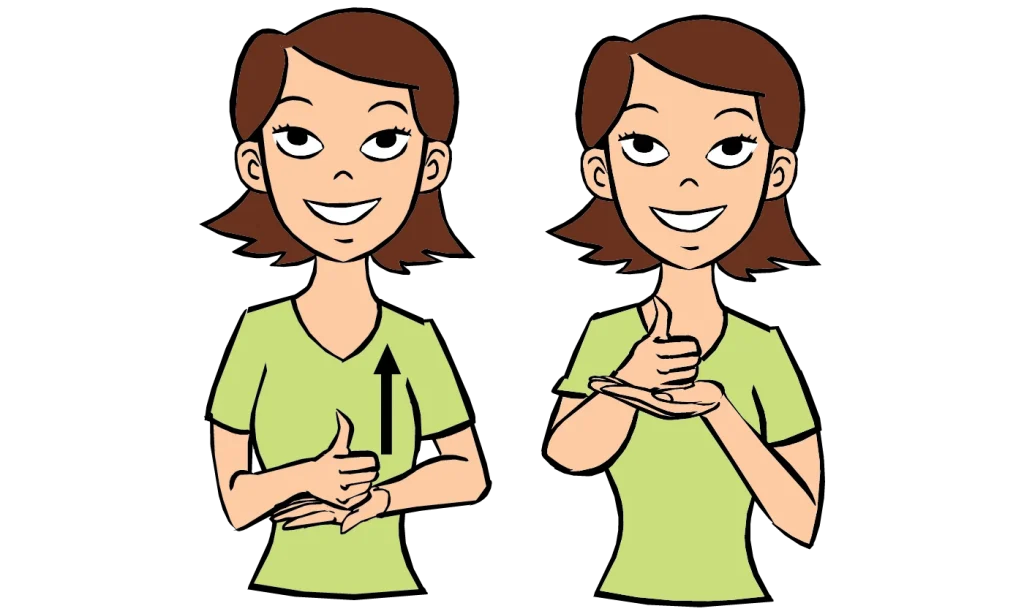
Please
When signing “please,” the right hand is opened and placed on the chest. Move the hand in a clockwise motion, keeping it flattened against your chest.
Politeness and respect are what this sign communicates therefore it is crucial in day-to-day communication. Courtesy can be expressed in this way, thus facilitating good interrelations.

Thank you
To show “thank you” make a fist with your dominant hand and place your fingers on your chin. Move your hand forward slightly then down making a small arc as if blowing out a kiss. This gesture implies appreciation or gratitude thus it is one of the main signs that anyone should know about.
Communicating thanks and promoting goodwill during social interactions can be achieved by using this signal frequently.

I’m Sorry
To sign “sorry,” make a fist with your dominant hand and put it on top of your chest. On the left side of the chest, move the knuckles in circular motions, showing regret or apology.
This sign helps to communicate remorse or admit fault when necessary. This is an appropriate channel through which you may express regret by apologizing to others.

Yes
To signify “yes,” close one’s dominant hand into a fist and nod up and down as if approving something with just head gestures; as such, agreement or affirmation can be effectively transmitted using simple movements made by hands alone.
At least it seems so hereby you may indicate consent or positive response while communicating by employing this gesture within any conversation between people.
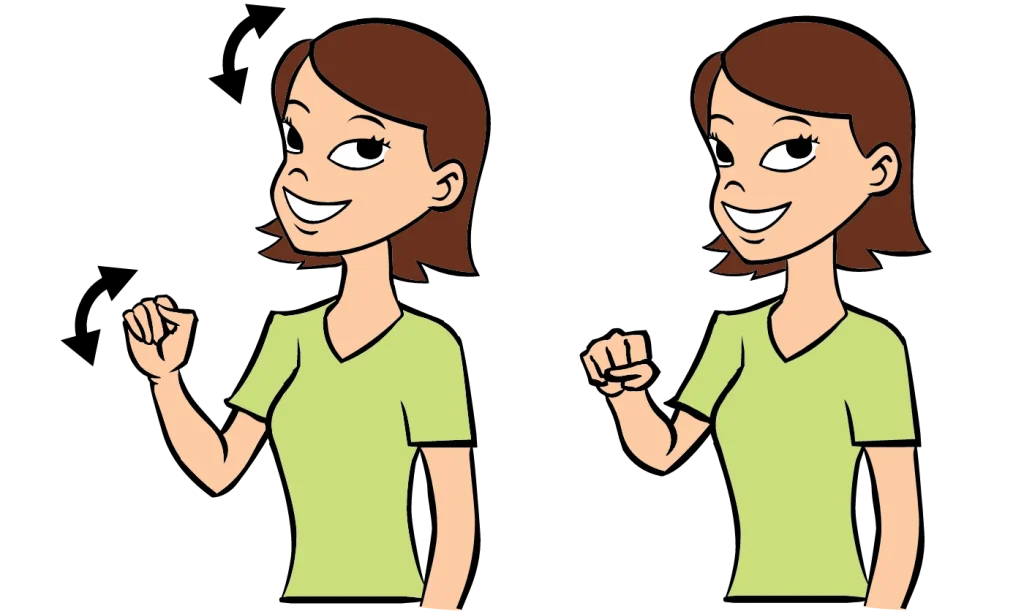
No
To mean “no” simply hold open thumb, index finger as well as middle finger upwardly extended. Are shown by tapping the index 1st finger against the middle 2nd finger with the thumb off-center of them like they were opening or closing their mouth.
In such cases where someone wants to give a negative answer, then he/she should use this particular kind of sign language by showing a dissenting position towards anything being discussed either verbally or orally in a compact, understandable.
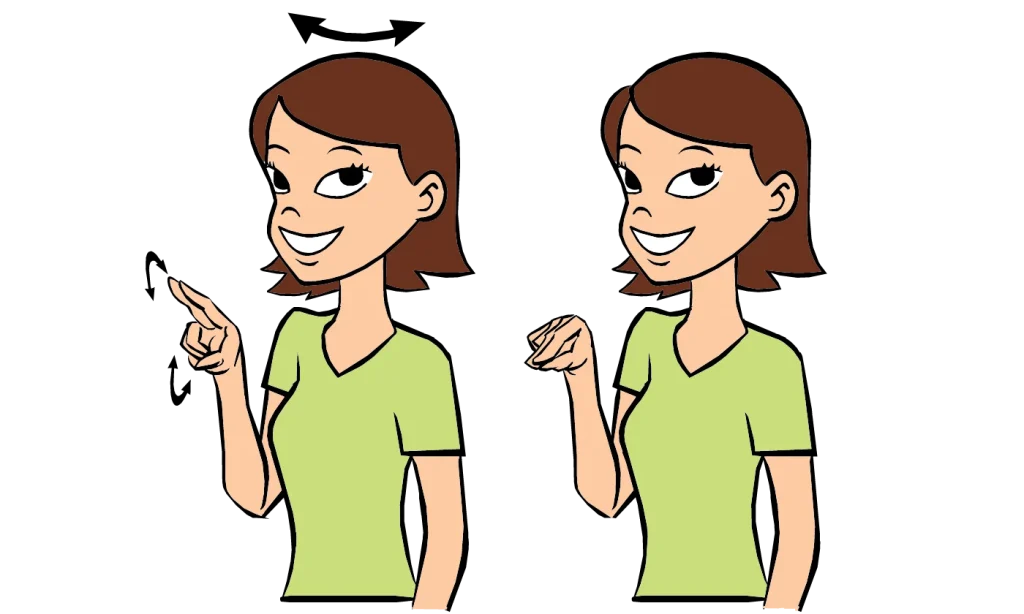
Finished/Done
The sign language for ‘finished’ or ‘done’ is indicated by opening both hands and palms facing you. The outward rotation of the hands results in a change in the position of the palms.
This motion indicates that something has come to an end or that an activity has been completed. Therefore, this sign can be used to demonstrate that a given task has been finished.
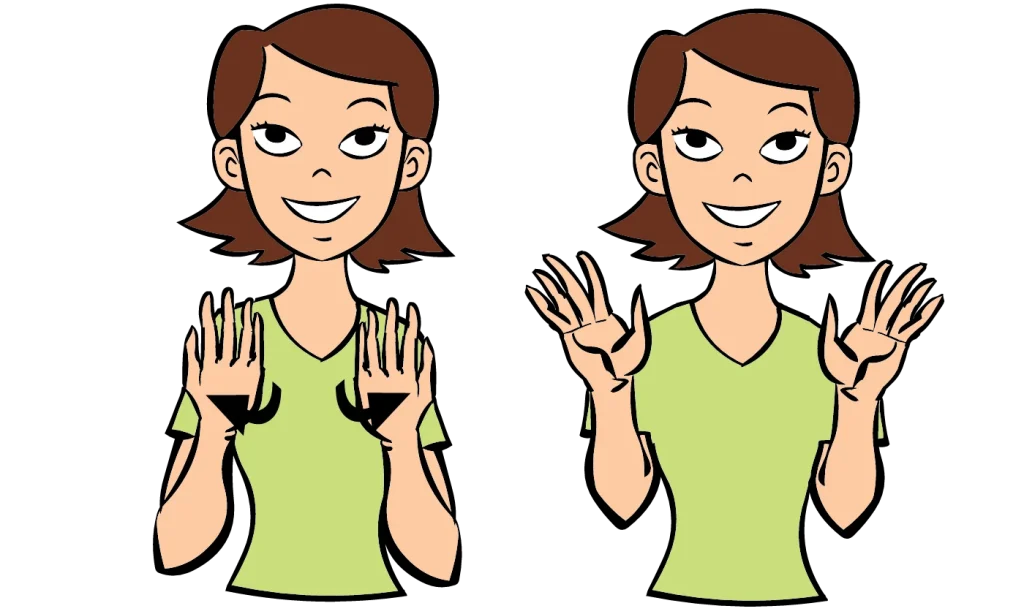
How to Begin Learning
E-Learning Platforms
Many online resources and apps are available for acquiring sign language skills. ASL University, among others, provides tutorials and free resource materials on this subject matter.
These platforms contain lessons, drills, and other modes of presentation, such as videos; thus learners are capable of studying in their comfort zone.
Community Classes
Sign language courses are offered in many communities through local schools, community centers or organizations serving deaf people. These classes offer practical learning experiences together with opportunities for students to practice with one another.
Furthermore, attending these courses may enable them establish relationships with a nearby group of deaf individuals thereby fostering education and understanding between them.
Practice with Deaf Individuals
Participation in the life of the deaf community is considered one of the most effective ways to learn sign language fluently. Practicing with native users helps attain fluency as one becomes familiar with cultural norms.
Most deaf people are willing to share their language and culture, so practicing with them becomes educative as well as enjoyable.
Regular Practice
Mastering sign languages, like mastering any other dialect, demands consistency. Daily exercises, such as conversational exchanges, watching video clips, or flashcards, enhance knowledge retention and build proficiency.
Studying regularly, therefore, offers good chances to improve your linguistic skills faster while keeping them longer in memory.
COMMON MYTHS
Sign Language is Universal
Contrary to popular belief, sign language is not universal. There are hundreds of different sign languages worldwide, each with unique structures and vocabularies.
For example, American Sign Language (ASL) differs from British (BSL) due to cultural and linguistic diversity among deaf communities globally.
Sign Language is Just Gestures
It is a complex, fully developed language with its grammar and syntax. It is not merely a collection of gestures but a rich form of communication conveying nuanced meaning.
Just as spoken languages are complex and sophisticated so are sign languages capable of expressing abstract concepts, emotions, and detailed narratives.
Learning Sign Language is Easy
Learning sign language, though accessible requires time, practice, and dedication for one to be fluent in it. Like any other new language learning it entails acquiring a set of new skills as well as understanding the cultural contexts involved therein.
While becoming proficient can be challenging, consistent effort and practice make this entirely achievable. The process of learning sign language itself is rewarding as it opens up new dimensions for communication and connection.
DIFFERENT TYPES OF SIGN LANGUAGE
American Sign Language (ASL)
ASL is the most widely used sign language in the United States and parts of Canada, where its grammar is even distinct from English’s. ASL evolved from French Sign Language (LSF) and indigenous sign languages into a unique linguistic system.
It employs one-handed alphabets, facial expressions, and body movements to convey meanings, thus making it an active, expressive type of speech.
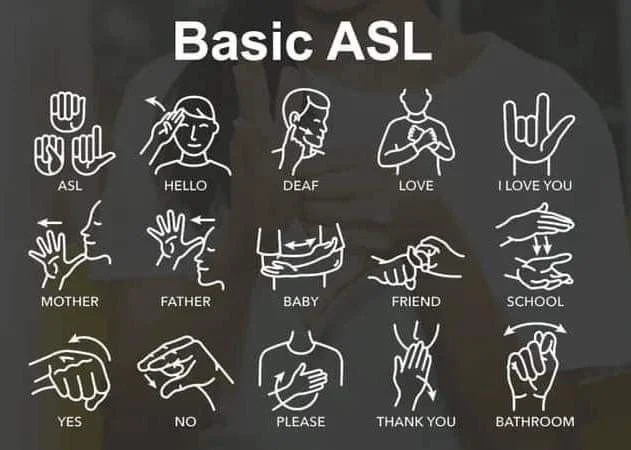
British Sign Language (BSL)
Also used in the United Kingdom BSL greatly varies from ASL in terms of hand shapes, movement, and grammar symbols applied when signing out words or sentences by hand respectively. BSL uses two-handed alphabet systems alongside having specific sets of signs and linguistic rules.
BSL developed under different historical and cultural factors exclusive to the UK, signifying its independence.
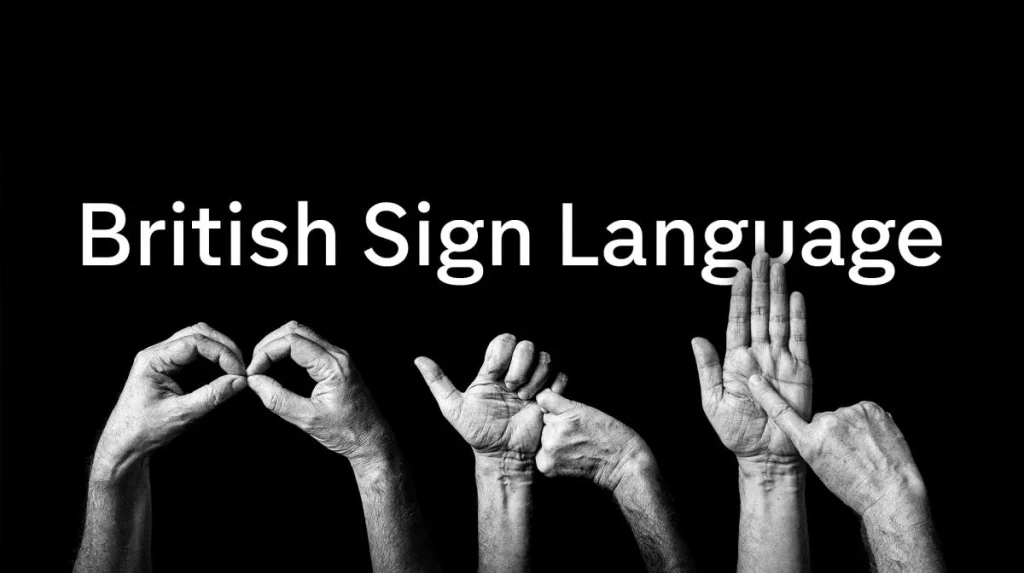
Other Sign Languages
There are many other sign languages around the world, including:
- Aslant: Australian , a blend of British and Irish sign language influences.
- LSF: French , one of the oldest and most influential types of signing globally.
- ISL: Irish , which has unique characteristics and a distinct history from other forms of signing.
CULTURAL SIGNIFICANCE
Deaf Culture
It is an inseparable part of Deaf culture that has its traditions, values, and norms. For effective and respectful communication, it is important to understand and respect Deaf culture. Deaf culture emphasizes visual communication, shared experiences, and a strong sense of community.
Full participation in this rich cultural heritage requires fluency in sign language.
Celebrations and Events
Such celebrations as Deaf Awareness Week or International Day of Sign Languages mark various milestones in deaf culture. These events raise awareness of sign language and Deaf culture among people.
They also function as platforms for advocacy, education, and community building that bring to the fore accomplishments made by deaf individuals and their contributions to society.
Art and Literature
Deaf art and literature also use sign language, including poetry, storytelling, and theater. These creative forms are how deaf people celebrate themselves and their language; they show the beauty of sign language in all its dimensions.
Complex stories and emotions are expressed through sign language by deaf artists and performers making a vibrant cultural landscape.
Technology and Sign Language
Assistive Technologies
Technological improvements have had a positive impact on the lives of those with hearing disabilities. Besides improved communication devices like video phones or captioning services to facilitate effective communication with others who do not know how to sign.
These technological developments enable information to be shared in real-time from long distances so as many people as possible can access it.
Learning Apps
There are many apps that can be used for learning sign language such as The ASL App among others SignSchool. This means that learners can easily study or practice what they learned using these apps which normally offer interactive lessons.
For example, there might be videos showing how signs are made or questions that will help users remember vocabulary or phrases.
Social Media
Sign language content is shared on social media sites, which also bring together different members, thus creating awareness of this form of disability among others. Platforms, where influencers as well as tutors come out strongly for sign language meant for public attention, have been instrumental in sensitizing the world about Deaf culture at large.
As a result of this new possibility people who cannot speak but hear well may communicate with each other thanks to social media platforms.
Conclusion
It is an important tool used in global communication and fostering inclusivity. Learning how to use this form of non-verbal communication allows one not only be able interact but also understand deaf community better thus improving their social skills and making the world a friendlier place for all human beings despite any differences we might have amongst ourselves.
Start now; you can’t wait to see how much signing transforms your world.
FAQs
What is the best way to learn sign ?
The best method of learning American Sign Language (ASL) involves online resources coupled with attendance of community classes along with exposure to more experienced speakers.
One needs constant interaction through conversation with native speakers that help understand better nuances of signing grammar in terms of referencing specific situations rather than just thinking about rules taught in class for instance.
Is sign language the same in all countries?
Sign language varies from country to country. That is, each country has its sign language with its unique rules of grammar and vocabulary. The diversity in sign languages is due to cultural exchange, which took place over generations among different communities, resulting in the development of various signs for words and phrases.
How long does it take to learn it?
The time taken to acquire skillfulness in signing largely depends on individual commitment, practice, and exposure. It may take a few months for basic fluency while mastering the language completely could last for years.
It has been proved that one may quickly learn this type of communication if he/she constantly practices it under real-life conditions where people communicate using gestures rather than orally.
Can hearing people learn sign language?
Hearing individuals and deaf ones are encouraged to learn sign language. By this, they show their ability to live harmoniously with other members of society besides promoting more effective communication and understanding about Deaf culture at large.
Furthermore, learning the art can be beneficial to ordinary citizens since it develops cognitive abilities as well as provides them with an opportunity to communicate meaningfully with those who cannot speak or hear.
What are the benefits of learning sign language?
These include increased intellectual capacity, better relationships, greater job prospects, and improved mental health, among others. This will also foster inclusion, thereby building supportive communities with mutual understanding between neighbors or colleagues regardless of whether they hear or not, for instance.
Acquisition of skills necessary for using a communication medium consisting mostly of gestures is likely going in many different ways to enrich your life.

Russell F. Jones, holding a Master in psychology from the University of Florida. He writes for Smart Parent Solutions, offering practical advice on parenting and child development. His engaging content helps parents navigate family life with confidence and ease. Russell enjoys sharing his knowledge and spending quality time with his family.
